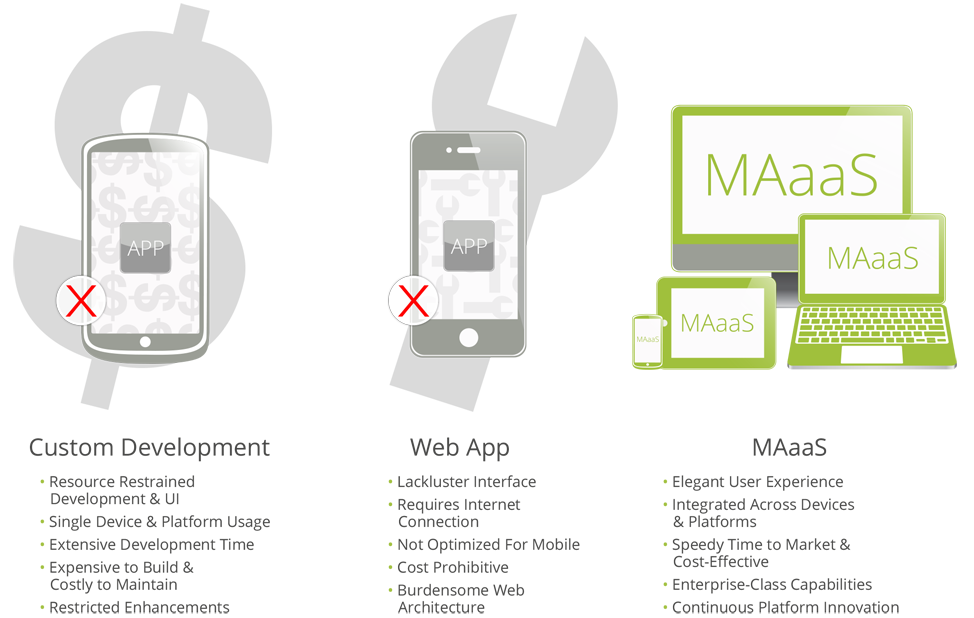Software as a service, or SaaS, is an effective way to integrate client-server applications and data synchronization by using web-based applications. It also reduces internal operating costs and helps lower total cost for each customer. This software delivery model shift from on-premise to on-demand functionality has revolutionized the way that companies roll out new technology. It has made the process faster, cheaper and allows for collective innovation that all users can leverage. How does SaaS continue to evolve? MAaaS, or mobile applications as a service, is the next logical step in the enterprise delivery model chain.
SaaS Moves to a New Frontier
Today, the new frontier is mobile and how to leverage mobile apps to enable core business functions and facilitate transformational mobilization.
- Tablets, smart phones and wearable technology have clear benefits of use in the B2C world, but with the consumerization of IT, business users expect the same level of innovation and ease of use in their business apps.
- BYOD might soon start riots in the workplace. Well, maybe not riots, but it’s definitely the cause of some discourse between IT and mobile workers.
- In a reactive effort to address this mobile shift, SaaS providers are creating mobile versions of their solutions that are falling short in multiple ways: usability, flexibility of use across multiple platforms (iOS, Android and Windows8), and adequate translation of their web-based app into a mobile app.
It’s time to apply the elements and core principles of SaaS to the mobile frontier. Mobile applications as a service is a mobile-first enterprise delivery model driving faster, better and smarter mobilization via an intuitive and integrated mobile platform.
MAaaS is the Optimal Enterprise Delivery Model

HTML5, Custom Apps, and MAaaS are the most common application deployment models. All these models can be useful, but a web-based HTML5 application can have downsides. The biggest problem a HTML5 model can face is the fact that the application cannot function when you are offline. And as for custom apps, the time and money you put into the application can quickly backfire. To update your app, you must spend more time and more money with its creator. The best solution is to meet somewhere in the middle with MAaaS. You have the ability to customize, updates are readily available and it works offline.
Similar to SaaS, MAaaS is innovative because it provides basic needs of the enterprise while reducing costs.
MAaaS has the ability to integrate individualized features unique to each customer’s needs. Under each layer is a well-developed application that is compatible with all devices. Because MAaaS is built on an existing format, it is able to grow, change and adjust to common problems that may arise. All of these features make MAaaS the most effective application deployment model.
By leveraging MAaaS, you aren’t building from scratch, but you also aren’t abandoning all sources of creativity and design either. Most companies think that they have to choose between building a custom app in-house or leveraging a high-cost provider. The answer is neither. Many companies can launch a custom app, but then fail at upkeep. They struggle to innovate, deploy the app across multiple mobile platforms, and maintain the enterprise grade parameters necessary in a B2B environment.
Recognizing the Value That MAaaS Can Provide For Your Organization
With Mediafly, we recognize that mobile is more like navigating a series of obstacles, many of which you don’t know until you get started. Do you need:
- More interactive content
- Different ways to discover the content via a custom user interface
- Implementation of more targeted content delivery (e.g. regional)
- Ability to add new divisions and varied use cases
Having a trusted partner that offers the flexibility of MAaaS and understands the need for a mobile-first approach is the only way to see the full benefits of enterprise mobility. MAaaS is the logical and cost-effective approach to keeping mobile enterprises truly innovative.
Mediafly is the right partner for this transformative approach. Let us introduce you to all the great ways we’ve already incorporated MAaaS for other enterprises.


Comments are closed.